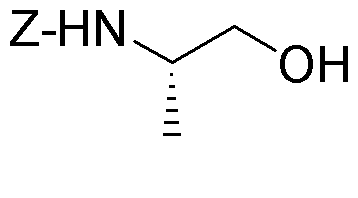Z-L-alaninol is widely utilized in research focused on:
- Pharmaceutical Development: It serves as a key intermediate in the synthesis of various pharmaceuticals, particularly in the production of amino acid derivatives that can enhance drug efficacy.
- Peptide Synthesis: This compound is crucial in the formation of peptides, which are essential in developing therapeutic agents and vaccines, offering advantages in specificity and potency.
- Chiral Catalysis: Z-L-alaninol is employed as a chiral auxiliary in asymmetric synthesis, helping researchers create enantiomerically pure compounds, which are vital in drug formulation.
- Biotechnology: It is used in the modification of biomolecules, improving the stability and activity of enzymes and proteins, which is essential for biocatalysis and industrial applications.
- Research in Organic Chemistry: The compound acts as a building block in various organic reactions, allowing chemists to explore new synthetic pathways and develop innovative materials.
General Information
Properties
Safety and Regulations
Applications
Z-L-alaninol is widely utilized in research focused on:
- Pharmaceutical Development: It serves as a key intermediate in the synthesis of various pharmaceuticals, particularly in the production of amino acid derivatives that can enhance drug efficacy.
- Peptide Synthesis: This compound is crucial in the formation of peptides, which are essential in developing therapeutic agents and vaccines, offering advantages in specificity and potency.
- Chiral Catalysis: Z-L-alaninol is employed as a chiral auxiliary in asymmetric synthesis, helping researchers create enantiomerically pure compounds, which are vital in drug formulation.
- Biotechnology: It is used in the modification of biomolecules, improving the stability and activity of enzymes and proteins, which is essential for biocatalysis and industrial applications.
- Research in Organic Chemistry: The compound acts as a building block in various organic reactions, allowing chemists to explore new synthetic pathways and develop innovative materials.
Documents
Safety Data Sheets (SDS)
The SDS provides comprehensive safety information on handling, storage, and disposal of the product.
Product Specification (PS)
The PS provides a comprehensive breakdown of the product’s properties, including chemical composition, physical state, purity, and storage requirements. It also details acceptable quality ranges and the product's intended applications.
Certificates of Analysis (COA)
Search for Certificates of Analysis (COA) by entering the products Lot Number. Lot and Batch Numbers can be found on a product’s label following the words ‘Lot’ or ‘Batch’.
*Catalog Number
*Lot Number
Certificates Of Origin (COO)
This COO confirms the country where the product was manufactured, and also details the materials and components used in it and whether it is derived from natural, synthetic, or other specific sources. This certificate may be required for customs, trade, and regulatory compliance.
*Catalog Number
*Lot Number
Safety Data Sheets (SDS)
The SDS provides comprehensive safety information on handling, storage, and disposal of the product.
DownloadProduct Specification (PS)
The PS provides a comprehensive breakdown of the product’s properties, including chemical composition, physical state, purity, and storage requirements. It also details acceptable quality ranges and the product's intended applications.
DownloadCertificates of Analysis (COA)
Search for Certificates of Analysis (COA) by entering the products Lot Number. Lot and Batch Numbers can be found on a product’s label following the words ‘Lot’ or ‘Batch’.
*Catalog Number
*Lot Number
Certificates Of Origin (COO)
This COO confirms the country where the product was manufactured, and also details the materials and components used in it and whether it is derived from natural, synthetic, or other specific sources. This certificate may be required for customs, trade, and regulatory compliance.


